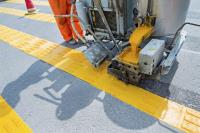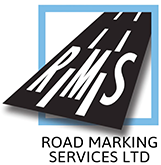 Add My Company
Add My Company
Sign In
Road Marking FAQs
03-07-2016

Road markings can be used for a variety of purposes over a number of different applications. On the road, on the playground, in car parks, sports courts and also on airport runways – and more. But despite the widespread use and benefits of road marking materials, there are some fundamental questions and queries that are useful to get your head around, so you understand how road markings work and what preparation might be needed before they are applied.
The team here at Road Marking Services have put together this FAQ so you can get acquainted with the basics behind road marking materials.
What is road marking paint made of?
The type of marking paint to be used depends largely on the type of job being done. That said, the majority of work is carried out with thermoplastic, which consists of synthetic resins and premix glass beads. When thermoplastic is not used, there are other high performance resins which can. Methyl Methacrylate, also known as MMA or Cold Plastic is often used, but there are others such as: epoxy paint, water-based paint, acrylic based paint and chlorinated rubber paint.
Is it possible to remove existing line markings?
It is. Even though road markings are designed to be durable and long lasting – making it naturally harder to remove them if the need arises – the use of specialist equipment and techniques makes line removal possible and efficient, with minimal disruption to traffic and the road surface itself.
Hydroblasting – the use of high pressure water jets – will remove any line marking with absolute precision, while causing minimal damage to the existing road surface. It is a quick and easy way to remove line markings and can be performed at any time. Scabbling and burning off are also good methods of removal of existing lines.
Does my road surface need to be cleaned before road markings are applied?
Before any road marking paint is applied, the surface may need to be prepared. This includes making sure that the surface is clear of any obstruction, all dirt, dust and litter is swept away. The surface should remain clean while the markings are laid. Concrete surfaces should have a good quality tack coat applied before thermoplastic (hot or cold) is laid.
Can road markings be applied when it is raining?
While line removal can take place in any weather conditions, road markings should not be applied in the rain. The materials will fail to bond with the surface in the wet, which defeats the object of applying them in the first place. The surface must be dry before any marking takes place. Force drying by the use of a gas torch or a thermal lance is possible.
How long do road markings take to dry?
Thermoplastic road markings are popular in part due to their fast drying capabilities. Thermoplastic markings will only take five minutes to sufficiently dry. MMA cold plastic is also quick setting, while water-based and other road marking paints will take longer.
How long until I can drive on the new road markings?
This depends on the type of marking material being used. Thermoplastic will be okay to drive on after a few minutes, while other materials will be longer.
Road Marking Services are one of the UK’s leading road marking contractors, providing clients all across the UK with efficient and professional road marking services in a variety of sectors. Our marking services are perfect for a wide range of applications including: car parks, warehouses, roads, playgrounds and sports courts. We also offer expert line removal services if you have markings that need to be removed or replaced. Get in touch with Road Marking Services today for all your surface marking needs.
For more information on Road Marking FAQs talk to Road Marking Services
Enquire Now
List your company on FindTheNeedle.

